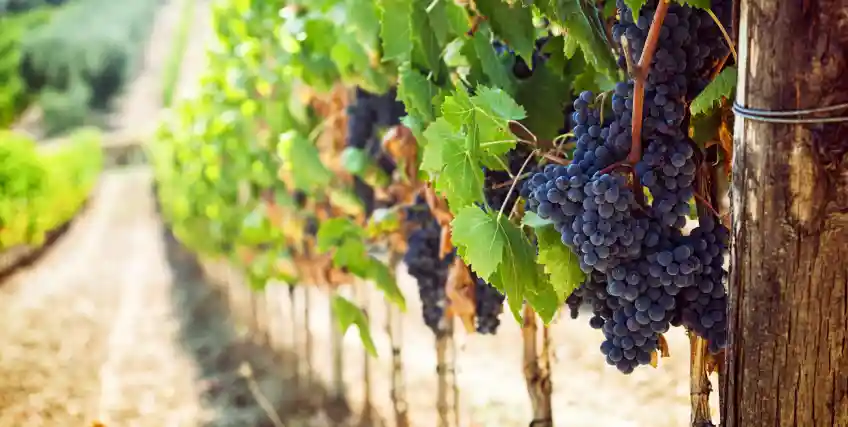How California Vineyards Can Use Commercial Loans to Fund Smarter Irrigation
August 05, 2025 | Last Updated on: August 05, 2025

California’s wine country has a water problem and it’s not new. With droughts hitting harder and wells running dry, vineyard owners are scrambling to rethink how they irrigate. From Napa to Paso Robles, growers are ditching flood systems for smarter ones like drip irrigation, reservoir setups, and well retrofits. But here’s the thing, . these upgrades don’t come cheap.
This is where commercial loans in California are stepping in. They're becoming the go-to solution for vineyard owners trying to stay ahead of worsening water shortages. Whether you run a small organic operation or manage hundreds of acres, these loans let you act now, before the next dry season sets in.
Why does it matter? Because better irrigation isn't just about survival. It’s about keeping grape quality intact, preserving long-term soil health, and keeping production moving without putting more strain on natural aquifers. The switch to smarter water systems is also gaining support through state-backed resources, but those are limited and take time.
So, for those looking to get financing for vineyards quickly and in sync with seasonal revenue cycles, commercial loans in California may be the fastest route. These loans are structured to meet the unique challenges vineyard owners face like fluctuating cash flow, long harvest gaps, and steep upfront equipment costs.
Why Water Efficiency Is Now a Business Priority
If you're growing grapes in California, water isn't just a utility—it’s a business asset and wasting it is not just bad practice; it’s bad business.
That’s why more vineyard owners are turning to commercial loans in California to upgrade their irrigation. Let’s break down why water efficiency isn’t optional anymore.
1. Climate Shift & Business Impact
The real estate market might fluctuate, but climate patterns? They're getting worse. With Southern California seeing record heat and less rainfall, vineyards face real crop loss. And no grapes mean no revenue. The right irrigation reduces risks while preserving working capital and soil quality for the long haul.
2. Rising Costs of Inaction
Failing to act now can mean spending more later. Emergency water sourcing, equipment rental, and damaged vines can wreck your cash flow. With interest rates climbing, locking in competitive rates through commercial loans in California gives vineyard owners the edge, before problems spiral.
3. Long-Term Sustainability Boosts Value
Eco-smart practices like drip irrigation or reservoirs improve vineyard valuation. Whether you’re refinancing or prepping for a future business loan for winery, showing sustainability matters. Especially to lenders, appraisers, and even younger buyers who care about climate-conscious agriculture.
Smart Irrigation Upgrades to Invest In
Let’s face it - old irrigation setups don’t cut it anymore. Water waste, runoff, and rising energy bills hurt margins. That’s why vineyard owners are putting commercial loans in California to work in these smarter, drought-ready upgrades.
1. Drip Irrigation Systems
These deliver water straight to the root zone, minimizing waste and maximizing grape quality. It’s the gold standard now in the winery industry financing investments. Bonus? It cuts labor needs too.
2. Reservoir Construction
Build your own reservoir and reduce reliance on public water. Great for storing rainfall during wet months, it stabilizes cash flow during dry seasons and builds long-term resilience.
3. Well Deepening or Drilling
Water tables in Los Angeles and San Diego are dropping. Many vineyard owners are using business loans to deepen wells or install energy-efficient pumps. That reduces reliance on pricey water hauls.
4. Soil Moisture Sensor Tech
Used with drip systems, these devices detect exactly when soil needs water. It stops overwatering and adds precision, making every drop count.
5. Automation & Remote Monitoring
Through mobile banking-style apps, owners can manage irrigation on the go. These tools are often financed through commercial loans in California for their proven ROI.
How Commercial Loans Are Structured for Vineyards
Wine money doesn’t come in every month. Vineyard income is seasonal, and loan structures need to respect that rhythm. Thankfully, most commercial loans in California are built with that reality in mind.
1. Seasonal Repayment Schedules
Unlike monthly payment plans, many business owners opt for seasonal or quarterly repayments. That way, you repay after harvest when revenue comes in. Smart lenders understand grape cycles and let you time your loan payments accordingly. It’s not just easier; it’s survivable.
2. Loan Types That Fit
From term loans to commercial real estate loans and even lines of credit, California vineyards have options. A business loan for winery purposes can be structured to match capital needs at different growth stages.
3. Fixed vs. Variable Rates
With interest rates still unpredictable, some vineyard owners prefer fixed rates to manage long-term budgeting. But if you expect rates to drop, variable rates could offer short-term savings. Choose based on your risk appetite and loan amount needs.
Pros and Cons of Using Commercial Loans
Every funding option has trade-offs. And while commercial loans in California offer serious benefits, they're not magic money. Let’s weigh both sides.
Pros
- Immediate Upgrades: You don’t need to drain your savings accounts, or delay installations. Just fund what you need now.
- Seasonal Flexibility: Many lenders offer payment terms that sync with your vineyard’s seasonal cash flow.
- Builds Business Credit: Timely repayment can help improve your credit score and make future refinancing easier if the lender reports to credit bureaus.
- Long-Term ROI: Smart irrigation reduces water bills and vine loss. So, your vineyard’s profit margin looks better over time.
- Ownership & Value: Unlike leasing, your upgrades (pumps, wells, etc.) become owner-occupied assets, thereby improving land appraisal.
Cons
- Risk if Crops Fail: If harvest tanks, so does your ability to repay. It’s a gamble, especially in dry years.
- Interest Costs Add Up: Even with competitive rates, you’ll pay more over time compared to out-of-pocket.
- Application Can Be a Hassle: Not all lenders get agri-business. The underwriting process can feel slow or overly strict.
- May Require Collateral: Most commercial loans in California will tie to your land, equipment, or even commercial property.
Alternatives to Commercial Loans in California
Not every vineyard wants or qualifies for commercial loans in California. Luckily, you’ve got other tools to fund smarter irrigation. Some are slower, some more flexible. But they’re all worth considering.
USDA and State Ag Grants
Programs like USDA REAP (Rural Energy for America Program) offer financing options for energy-efficient farm improvements, including drip systems. They’re competitive and paperwork-heavy, but if approved, you won’t have to pay interest.
Co-Op Investment or Shared Systems
Neighboring vineyards sometimes pool funds to build reservoirs or bulk-purchase tech. It's low-cost and communal but depends on strong partnerships and similar water needs.
Leasing Irrigation Equipment
Some suppliers offer leases for pumps and sensors. It reduces upfront cost, though you won’t own the equipment. Good for short-term needs, not so great for equity growth.
Green Energy Tax Credits
Installing solar pumps or automated systems? You might qualify for federal or state tax credits under winery industry financing incentives. Check with your business banking advisor.
SBA Microloans
If you're just starting or need a modest amount, SBA microloans can bridge the gap. These are government-backed, up to $50,000, and may come with better rates than private lenders. Use them to fund small-scale irrigation gear, sensor installation, or well repairs. They're great when you're not quite ready for full commercial loans in California but still need cash to move forward.
Lines of Credit
Sometimes you don't need all the money at once. A line of credit lets you borrow as needed, thus making it perfect for emergency irrigation fixes or staged upgrades. Unlike a fixed loan, you only pay interest on what you use. It's popular among vineyard owners juggling loan payments, harvest income, and repairs. Used wisely, it can supplement larger commercial loans in California or cover you during off-season slowdowns.
Conclusion
Water isn't just a utility for California vineyards; it's survival. And with droughts becoming the norm, waiting for rain just isn't an option anymore. Smart irrigation isn’t a fancy upgrade. It’s a necessity. Whether you're deepening a well, adding a reservoir, or installing drip lines, these systems help your vineyard stay productive and profitable, even when nature plays rough.
However, those systems aren't cheap. That’s why commercial loans in California are proving to be lifelines for vineyard owners. They’re not just about borrowing; they’re about creating a breathing room. The right loan structure can sync with harvest schedules, preserve cash flow, and even increase the value of your land or operation.
And if traditional funding doesn’t work for you? There are still grants, co-op models, and even SBA microloans to explore. In the end, your vineyard has unique needs. And whether it’s a business loan for winery upgrades or a revolving line of credit, there’s no one-size-fits-all. What matters is taking action before your soil turns dry, and your bottom line does too.
FAQs About Vineyards Can Use Commercial Loans in California for Smarter Irrigation
1. How do commercial loans in California help vineyard owners with irrigation?
They offer upfront funding to install efficient systems like drip irrigation, wells, and reservoirs. Most lenders tailor repayment schedules to match seasonal harvests, easing cash flow stress.
2. Can I use a commercial loan to install both a well and drip system together?
Many commercial loans in California allow bundled funding for multiple upgrades. It’s often better than applying separately and keeps repayment terms unified.
3. Do lenders consider seasonal income when underwriting?
A good commercial lending partner will structure payments around your harvest season and offer some grace during low-revenue months.
4. Can I refinance existing vineyard loans to add irrigation upgrades?
Many vineyard owners opt to refinance and fold in irrigation needs. This can improve terms and reduce your monthly loan payments.
5. What kind of documents do I need to apply?
You’ll likely need financial statements, vineyard asset lists, equipment quotes, and maybe a water usage plan. Some lenders also ask for a business or commercial property appraisal.
Frequent searches leading to this page
Related Articles
State of California Business Loans: Trends Driving Entrepreneurial Growth
December 3, 2025
Avoid the Debt Trap: Choosing the Right Loan for Your California Business
October 28, 2025
The Ultimate Guide to Small Business Grants: Unlocking Growth Opportunities
October 23, 2025
Term Loans are made by Itria Ventures LLC or Cross River Bank, Member FDIC. This is not a deposit product. California residents: Itria Ventures LLC is licensed by the Department of Financial Protection and Innovation. Loans are made or arranged pursuant to California Financing Law License # 60DBO-35839




